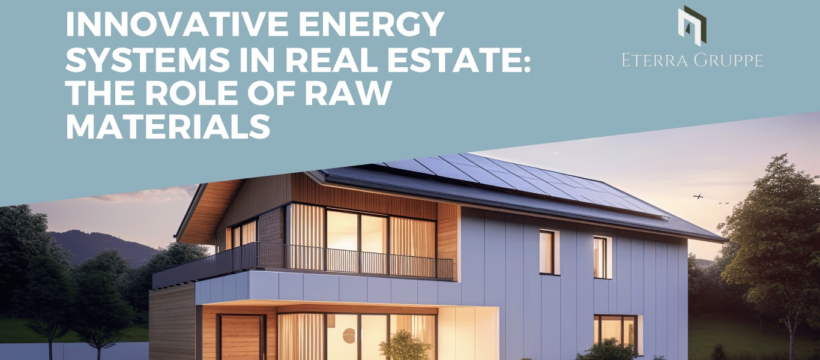On the way to a sustainable future: Intelligent energy management in real estate and the role of resources in the European Union – in conversation with Daniel Slenters and Sven Bading, real estate experts of the ETERRA Group from Magdeburg.
In a world shaped by existential challenges such as climate change, species extinction, and pollution, the construction industry is at the forefront. Worldwide, it ranks among the largest consumers of natural resources like wood, sand, and stone, contributing significantly to over 50 percent of global emissions. However, within this devastating footprint lies hope – the hope to preserve livelihoods and make the industry future-proof through intelligent energy management and innovative construction projects.
The real estate sector faces the challenge of implementing sustainable and efficient energy systems to meet rising energy demands while minimizing environmental impacts. Real estate experts from the ETERRA Group in Magdeburg rely on advanced energy systems with innovative resources.
Energy transition in real estate: Challenges and opportunities
The construction industry currently accounts for about 60 percent of global resource consumption, 50 percent of global waste, and over 35 percent of global energy use. It requires questioning old habits and rethinking buildings. Inspired by the Cradle-to-Cradle principle (C2C), the vision of the building revolution describes a climate-positive circular economy with healthy materials. Daniel Slenters explains that the C2C design concept developed by German chemist Michael Braungart and US architect William McDonough aims to create attractive markets through sustainable design, elevating sustainability and quality to the new standard. The key points of this building revolution are fascinating: energy self-sufficient buildings, environmentally friendly facades, promotion of healthy indoor air quality and microclimate, circular economy, zero-waste construction, and consideration of the regional sourcing of building materials.
Thinking about tomorrow today!
The energy transition has reached not only politics but also the real estate industry. Sven Bading sees humanity’s greatest challenge in leaving future generations with a livable environment. The European Union has laid out a concrete action plan in the „European Green Deal“ to become the first climate-neutral continent by 2050. To achieve these goals, technological tools are crucial. According to a study by the International Institute for Energy Economics and Policy, investments in sustainable energy systems lead to long-term economic benefits. The analysis shows that the use of renewable energies in buildings not only reduces energy costs but also promotes the appreciation of real estate.
Photovoltaic and solar technologies: Harnessing energy from the sun
A central pillar of innovative energy systems in real estate is the integration of photovoltaic and solar technologies. Sven Bading emphasizes that research by the Renewable Energy Research Institute shows that properties with photovoltaic systems can not only cover a large part of their own energy needs but also feed surplus energy into the public grid. This not only enables independence from fossil fuels but also contributes to the energy transition.
Geothermal energy: Harnessing the earth’s natural heat
The use of geothermal energy is another innovative way to integrate sustainable energy systems into real estate. Sven Bading explains that research results from the Geothermal Institute show that buildings with geothermal heating and cooling systems can achieve significant energy savings. The study highlights that the initial investments are justified by the long-term cost savings and environmental benefits.
Innovative battery storage systems: Storing for a sustainable future
The development of advanced battery storage systems is a key element for effectively using renewable energies in real estate. Sven Bading emphasizes that a study by the Institute for Energy Storage Technologies shows that modern battery storage systems not only improve the efficiency of renewable energies but also support grid stability. This underscores the importance of battery technologies in a sustainable energy future.
Smart energy management systems: Increasing efficiency and reducing costs
The implementation of smart energy management systems plays a crucial role in optimizing energy consumption in real estate. Sven Bading explains that studies by the Center for Intelligent Building Technologies show that properties with smart energy management systems can not only reduce energy consumption but also significantly lower operating costs. The analysis shows that investing in these technologies can lead to substantial savings in the long run.
The role of resources in the sustainable energy future of the real estate industry
Environmental technology plays a crucial role in implementing sustainable developments. Without technologies for generating and storing renewable energies, air and water purification, and promoting circular economy and sustainable consumption and production patterns, global sustainability goals cannot be achieved.
The challenges facing the construction industry are immense, but the solutions are within reach. By implementing smart energy management systems and applying the Cradle-to-Cradle principle, we can not only protect the environment but also shape a thriving, future-proof industry. „The building revolution is not a utopia – it is the path to a sustainable future for us and future generations,“ agree Bading and Slenters.
Author: Valentin Jahn – Futurist and Blogger
ETERRA Ibera SL is an innovative and future-oriented real estate company from Magdeburg that is committed to sustainable living. The company offers a wide range of services and works closely with its customers and investors to meet individual needs.
Kontakt
ETERRA Ibera SL
Matthias Claßen
Carrer Illes Canàries The Circle
07183 Santa Ponça
+49 151 615 6666 4

https://www.eterragruppe.com/
Die Bildrechte liegen bei dem Verfasser der Mitteilung.

